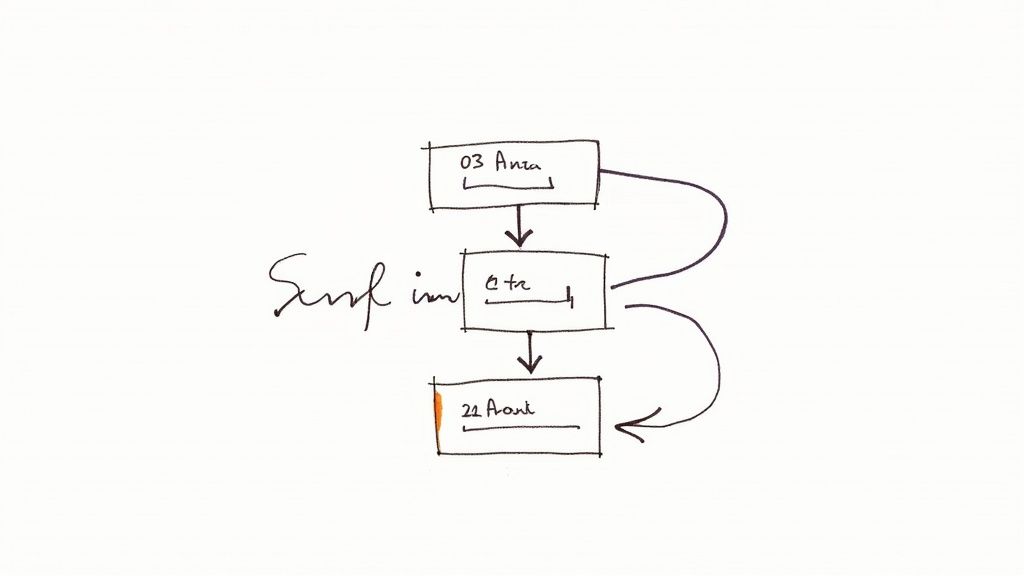How to Write Testimonials That Convert
Testimonials that engage readers and boost credibility. Discover tips to turn prospects into loyal customers.
- 12 min read

The Psychology Behind Powerful Testimonials

Consumers today are constantly exposed to marketing, leading to understandable skepticism. This makes trust a vital component in purchasing decisions. Testimonials act as a bridge, offering social proof and reassurance from others who've used your product or service.
This validation is especially helpful for new customers unfamiliar with your brand. Rather than simply accepting your claims, they can see tangible benefits experienced by others, boosting their confidence. This elevates testimonials from a simple marketing tactic to a strategic advantage for improving conversions.
Why Testimonials Work: Tapping Into Social Influence
Testimonials leverage social influence, a fundamental aspect of human behavior. We're naturally inclined to follow the actions of others, especially when unsure. This effect is stronger when we perceive those others as similar to ourselves or facing similar situations.
A well-crafted testimonial provides this relatable experience, making potential customers feel understood and more likely to follow suit. Think about how you choose a restaurant – are you more likely to trust the restaurant's description or the collective opinions on Yelp?
Building Trust and Reducing Anxiety
Risk aversion plays another key role. Buying anything involves some degree of risk. Testimonials mitigate this risk by showcasing positive results and reducing purchase anxiety. By highlighting benefits and successes, testimonials create a sense of security, encouraging potential customers to commit.
They effectively answer the question, "Will this work for me?" with concrete evidence. This is especially important when crafting testimonials that resonate with your target audience.
Furthermore, research supports the power of testimonials. Studies reveal that 92% of customers consult online reviews before buying, and 72% state positive testimonials increase their trust in a business. Interestingly, 73% of consumers read six or fewer reviews before forming an opinion.
This indicates that even a small collection of authentic and well-written testimonials can significantly impact potential customers. Find more detailed statistics here: https://cubecreative.design/blog/small-business-marketing/25-stats-about-using-testimonials-in-marketing
You might also find this helpful: 10 Reasons Reviews Can Grow Your Business. Understanding the psychology behind testimonials is essential for creating effective, conversion-driven content. By harnessing social influence and mitigating risk aversion, testimonials build trust, reduce anxiety, and ultimately drive sales.
How To Write Testimonials: The Proven Formula

Tired of generic, unconvincing testimonials? This section reveals the formula for crafting compelling testimonials that truly resonate with potential customers and boost conversions. We'll break down the structure of high-performing testimonials, showing you how to transform ordinary feedback into powerful social proof.
The Before-and-After Narrative
The most effective testimonials tell a story. This story often follows a simple, yet compelling, before-and-after structure. Start by outlining the customer's initial challenge or problem. Then, clearly explain how your product or service provided a solution.
Finally, showcase the positive outcome or result. This narrative arc makes the testimonial relatable and impactful, drawing readers in and demonstrating the value you offer.
For example, instead of a bland statement like "Product X is great!", aim for something more specific: "Before using Product X, I struggled to manage my social media. Now, I've doubled my engagement and saved hours each week!" This revised version paints a picture of the customer's journey and highlights the tangible benefits of using Product X.
Quantifiable Results: Show, Don't Just Tell
While emotional connection is important, supporting testimonials with quantifiable results significantly increases their persuasive power. Whenever possible, incorporate specific metrics and data.
Did your product increase sales by 15%? Did it save a client 20 hours per week? These concrete numbers demonstrate tangible value and add a layer of credibility that generic praise simply can't match. This data-driven approach is particularly effective with analytical buyers.
Balancing Emotion and Credibility
The sweet spot for persuasive testimonials lies in the balance between emotional resonance and credibility. Positive emotions create a connection with readers, while credibility ensures the testimonial is perceived as genuine and trustworthy.
Including a customer's name, title, and company, and even a photo or video, strengthens the testimonial's authenticity and builds trust. It's like a personal recommendation from a trusted source, making it far more believable.
The Proven Testimonial Formula
To recap, here's a simple breakdown of a compelling testimonial's key components:
- The Problem: Clearly define the customer's initial challenge.
- The Solution: Explain how your product or service addressed the problem.
- The Result: Showcase the positive outcome with quantifiable data whenever possible.
- Credibility Boosters: Include the customer's name, title, and company. A photo or video adds even more impact.
Adapting Testimonials Across Channels
The ideal testimonial structure may vary depending on the platform where it's used. A short, impactful quote might be perfect for a social media post, while a longer, more detailed testimonial could be better suited for a landing page or case study. The table below illustrates the core components of an effective testimonial structure.
To help illustrate the importance of each component, let's look at the table below:
This structured approach ensures that your testimonials resonate with your target audience and drive conversions. Remember, adapting your approach to different channels and customer segments will further maximize the effectiveness of your testimonials. By mastering these elements, you can transform customer feedback into a powerful engine for business growth.
Collecting Testimonials That Sound Authentic

The key to gathering powerful testimonials lies in knowing when and how to ask. Soliciting feedback at the right moment can be the difference between a generic response and a compelling story. This requires a more strategic approach than just sending a post-purchase email.
Timing Is Everything: Identifying the Optimal Moment
Imagine asking for a restaurant review before even tasting the food. It doesn't make sense. Likewise, asking for a testimonial immediately after a purchase is rarely ideal. Instead, target a time when the customer has experienced real benefits.
This could be after successfully implementing your product, achieving a milestone using your service, or overcoming a significant challenge. For instance, if you sell software like kisReviews, a good time to ask for a testimonial might be after a customer collects their first set of reviews. They’ve seen the value firsthand and can describe its impact.
Effective Interview Techniques: Unlocking Customer Stories
Even enthusiastic customers can have trouble expressing their experiences. Structured interview techniques can help. Preparing specific questions helps even hesitant customers articulate their thoughts. Avoid generic questions like, "What do you think of our product?"
Instead, try more specific inquiries:
- "What was your biggest challenge before using our product?"
- "How has our product helped you overcome that challenge?"
- "Can you share a specific example of how our product made a difference?"
- "What advice would you give to someone considering our product?"
Building a Systematic Collection Process
Successful brands systematize testimonial collection. This means integrating it into regular customer interactions, not just making one-off requests. Consider automating the process with targeted emails at key points in the customer journey.
You might find this interesting: How to master email for reviews. Offering incentives like discounts or exclusive content can also boost participation.
Furthermore, the quantity of testimonials influences perceptions of your business. According to Big Commerce, having 10 or more reviews can increase search traffic by 15-20%. 40 or more reviews are often needed for consumers to trust a star rating. Learn more about the impact of reviews here. This highlights the importance of a strong collection strategy to maximize both SEO and customer trust.
By strategically timing requests, using effective interview techniques, and implementing systematic collection processes, you can gather authentic testimonials. These testimonials resonate with potential customers and drive conversions. This proactive approach transforms testimonial collection from a passive activity into a powerful marketing asset.
Editing Testimonials While Preserving Authenticity

Finding the right balance between polished marketing material and a genuine customer voice is essential for effective testimonials. This section explores how to refine testimonials without losing their authenticity, protecting your brand, and maximizing impact.
Ethical Editing: Enhancing Clarity Without Distorting Meaning
Think of editing a testimonial like polishing a gem. The goal is to bring out its natural shine without changing its fundamental structure. Focus on clarity and conciseness while keeping the customer's unique voice and perspective.
You can fix minor grammatical errors and typos. Avoid rewriting entire sentences or altering the core message. For example, condense a rambling sentence while maintaining its original intent. Changing the sentiment or exaggerating claims, however, crosses an ethical line and hurts credibility. Prioritize honest representation.
Condensing Lengthy Feedback: Maintaining Emotional Resonance
Long testimonials can lose readers' attention. But simply cutting large sections can remove important emotional context. Instead, extract the most impactful phrases and stories.
Imagine a customer praising how kisReviews helped them get more reviews. They share a long story about a positive customer interaction thanks to a review request. Condense this anecdote while preserving the emotional core – the link between reviews and positive experiences. This highlights the most compelling parts without losing the emotional impact.
Collaboration is Key: Strengthening Endorsements Through Partnership
Working with the customer often produces the best edits. Sharing your proposed changes and explaining your reasoning promotes transparency and trust. This collaborative approach strengthens the endorsement.
It also allows the customer to clarify nuances or add details. This ensures the final testimonial accurately reflects their experience and maximizes its marketing potential. Collaboration leads to satisfaction and strengthens the relationship.
Protecting Your Brand: Ethical Guidelines and Best Practices
Ethical standards are paramount when editing testimonials. Always get the customer's explicit permission before publishing any edited version. Transparency builds trust.
Clearly disclose any incentives offered for the testimonial. This builds credibility and protects your brand’s reputation. Avoid unsubstantiated claims, even if the customer makes them in their original feedback. Overpromising damages long-term credibility. Following these ethical guidelines ensures testimonials are both powerful and trustworthy.
Strategic Testimonial Placement for Maximum Impact
Even the most glowing testimonials can miss the mark if they aren't placed strategically. This section dives into the psychology of effective placement across your marketing channels. We'll explore how successful brands use testimonials at key moments in the customer journey to boost their effectiveness.
Matching Testimonials to the Customer Journey
Presenting testimonials at the wrong time can be just as unproductive as asking for a restaurant review before the first bite. Different testimonials resonate at different stages of the customer journey.
Short, punchy quotes on social media, for instance, can capture attention and spark initial interest. Meanwhile, a detailed case study with quantifiable results is more convincing on a landing page for a prospect close to making a purchase. Grasping these subtle differences is essential for effective testimonial placement.
Website Placement: Guiding Visitors Towards Conversion
Strategic placement on your website can dramatically influence conversion rates. Putting testimonials near calls to action like "Get Started" or "Request a Demo" can give hesitant visitors the encouragement they need. Highlighting testimonials on product pages can alleviate specific concerns and increase buyer confidence.
Consider a tool like kisReviews to easily embed testimonials on your website, showcasing social proof right where potential customers are considering your products or services.
Email Marketing: Building Trust and Driving Action
Testimonials within email campaigns can nurture leads and foster trust. Include them in welcome emails to introduce new subscribers to the positive experiences of current customers. Adding testimonials to promotional emails can boost the credibility of your marketing messages and improve conversions.
Landing Pages: Addressing Objections and Boosting Conversions
Landing pages generally concentrate on a specific product or service. Featuring relevant testimonials here can tackle common objections and strengthen your value proposition. A strategically positioned testimonial can turn a skeptical visitor into a satisfied customer.
Social Media: Leveraging Social Proof for Wider Reach
Social media platforms are driven by social proof. Sharing testimonials organically or within paid advertising can significantly broaden your reach and establish trust with new audiences. Visual testimonials, such as photos and videos, are particularly impactful in this arena.
The Power of Visuals and Verification
Details like customer photos, company logos, and verification badges enhance the authenticity of testimonials, greatly increasing their believability. This helps potential customers connect with the testimonial personally, amplifying its impact.
To illustrate optimal placement strategies across various marketing channels, take a look at the table below:
To help you understand the optimal placement of your testimonials, we've compiled the following table:
Testimonial Placement Strategy by Channel
Optimal placement locations for testimonials across different marketing channels and why they work
As you can see, tailoring the format and placement of your testimonials to each specific channel can significantly enhance their effectiveness.
A/B Testing: Optimizing for Your Audience
The most effective way to pinpoint optimal placement is through A/B testing. Experiment with different locations, formats, and visual elements to identify what resonates most with your target audience. Continuously analyze and refine your strategy to maximize your testimonial’s impact. You might be interested in: How to master customer reviews. This constant optimization ensures your testimonials always perform at their best. By strategically positioning testimonials across your marketing channels and consistently testing and refining your approach, you can harness social proof to cultivate trust, address customer concerns, and ultimately boost conversions.
Legal Essentials for Testimonial Marketing
Navigating the legal side of testimonial marketing is vital for safeguarding your business and upholding the integrity of your campaigns. This section covers essential legal points and best practices for using testimonials effectively and legally. Understanding these guidelines will empower you to harness the persuasive power of testimonials while minimizing legal risks.
Securing Proper Permissions: The Foundation of Legitimate Testimonials
Before sharing any testimonial publicly, obtaining express written consent from the customer is paramount. This permission gives you the legal right to use their words and image for marketing. Securing consent protects you from potential legal disputes and ensures you're operating within legal boundaries.
A simple email confirmation isn't enough. A clear testimonial release form is essential. This form should explicitly detail usage rights, duration of use, and any potential alterations to the testimonial. This formal documentation protects both your business and the customer. This proactive approach demonstrates ethical practices and shields your business from future legal issues.
Disclosure of Material Connections: Maintaining Transparency and Trust
Transparency is key. If any material connection exists between your business and the reviewer (like a free product, discounted service, or affiliate partnership), it must be disclosed. This disclosure should be clear and noticeable, appearing directly alongside the testimonial.
For example, if a customer received a free trial of kisReviews in exchange for a review, this must be stated. Failing to disclose these connections damages trust and can lead to legal consequences. This practice ensures compliance with advertising regulations, such as those enforced by the Federal Trade Commission (FTC).
Substantiating Claims: Backing Up Testimonials With Evidence
Make sure your testimonials avoid making claims your product or service can't support. If a testimonial asserts your product "doubles sales overnight," you need data to prove it. Unsubstantiated claims mislead consumers and expose your business to legal action. Backing up claims protects your brand’s reputation and helps you avoid false advertising issues.
Navigating Industry-Specific Regulations: Tailoring Your Approach
Some industries have specific regulations around testimonials. For instance, health and beauty products often face stricter rules regarding claims and endorsements. Researching and complying with these regulations ensures your testimonials are legally sound and helps you avoid potential legal trouble. This focused approach ensures responsible and effective use of testimonials within your specific industry.
Creating Compliant Attribution Policies: Giving Credit Where Credit Is Due
Establish clear attribution policies to safeguard your brand. Define how customers should identify themselves in testimonials. This helps maintain compliance with privacy regulations and prevents potential misrepresentation. Well-defined attribution policies demonstrate your commitment to responsible marketing and build trust with your audience.
Practical Documentation and Compliance Checklists: Staying Organized
Keeping accurate records is crucial for legal compliance. Develop a system for storing signed release forms and tracking material connections. A compliance checklist is helpful for ensuring all testimonials meet legal requirements before publication. This organized approach simplifies audits and streamlines responses to inquiries. Maintaining readily available compliance records saves time and resources in the long run.
By implementing these strategies, you can cultivate a collection of powerful, legally sound testimonials that boost your marketing while protecting your business. A solid foundation of legal compliance allows you to focus on maximizing the impact of your testimonials.
Ready to easily gather and manage authentic customer testimonials? Start your free trial with kisReviews today and unlock the potential of social proof!
